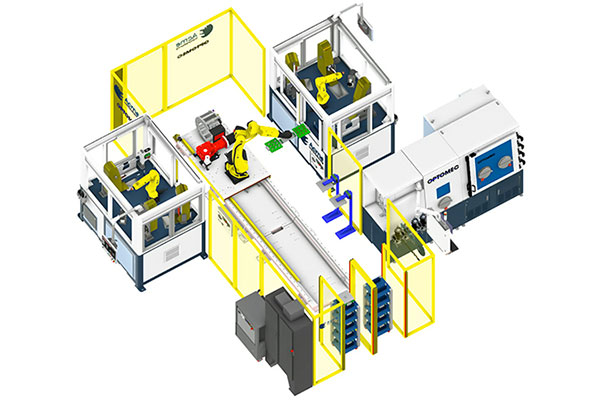Two Companies Unveil Automated Work Cell for Additive Repair of Turbine Parts
Turnkey solution includes integration of prep, additive repair and finishing functions.

ACME Turnkey Aerospace Blade Repair System. Image courtesy of Optomec and Acme Manufacturing.
Latest News
September 16, 2022
Optomec, a provider of 3D metal additive manufacturing (AM) solutions and Acme Manufacturing, maker of robotic material removal systems, have partnered to produce a fully automated work cell initially optimized for repairing aviation compressor blades made of titanium.
The turnkey work cell is the product of a 2-year collaboration between the companies working with input from commercial maintenance repair & overhaul (MRO) and U.S. Department of Defense repair centers for aircraft engines. The automated work cell has a repair capacity of 85,000 titanium compressor blades per year. Technologies used in the automated work cell are commercially available and have been certified by civil aviation authorities worldwide.
The entry-level work cell consists of three stations that enable blade tip grinding, 3D additive laser cladding and post clad finishing. The cell also includes an automated pallet load/unload station, a pallet flipping station, and a robotic material handling system. Each machine in the work cell is capable of automatically adjusting tool paths to accommodate blade-to-blade variations resulting from normal wear and distortion during service.
The Optomec CS-250 5-axis laser cladding machine will be used to produce high-yield precision welds for titanium compressor blades using LENS Directed Energy Deposition (DED) and AutoCLAD advanced vision and adaptive tool-pathing technology in a controlled argon atmosphere. The Acme Manufacturing MRO blade tip repair machines can be configured for blade tip grinding, weld blending and polishing.
The system is equipped with the auto path generation that allows for a high mix, low-volume environment.
Working in tandem, the systems in the work cell provide a productive real-world implementation of Industry 4.0 and digital thread concepts.
“Our collaboration with Acme Manufacturing has brought together complementary technologies that provide a compelling business case for customers,” says Jamie Hanson, VP of Business Development at Optomec. “Demanding repair requirements, driven by commercial and DoD repair centers, has led Optomec to enhance our DED capabilities to enable high volume, high-yield repair for compressor blades, an especially challenging objective for titanium parts.”
“Acme has delivered over 200 robotic material removal systems to the aerospace industry in the past 35 years largely for new part manufacturing. By utilizing efficient and repeatable robotic finishing technology, we will be able to enable MRO engine repair centers to improve overall component quality and help lower unit costs. I am excited about our teams’ developments in auto path generation, which allows us to enter a new market of automated material removal systems,” says G.A. “Fritz” Carlson III, president and CEO of Acme Manufacturing.
Sources: Press materials received from the company and additional information gleaned from the company’s website.
More Optomec Coverage
Subscribe to our FREE magazine, FREE email newsletters or both!
Latest News
About the Author
DE’s editors contribute news and new product announcements to Digital Engineering.
Press releases may be sent to them via [email protected].






